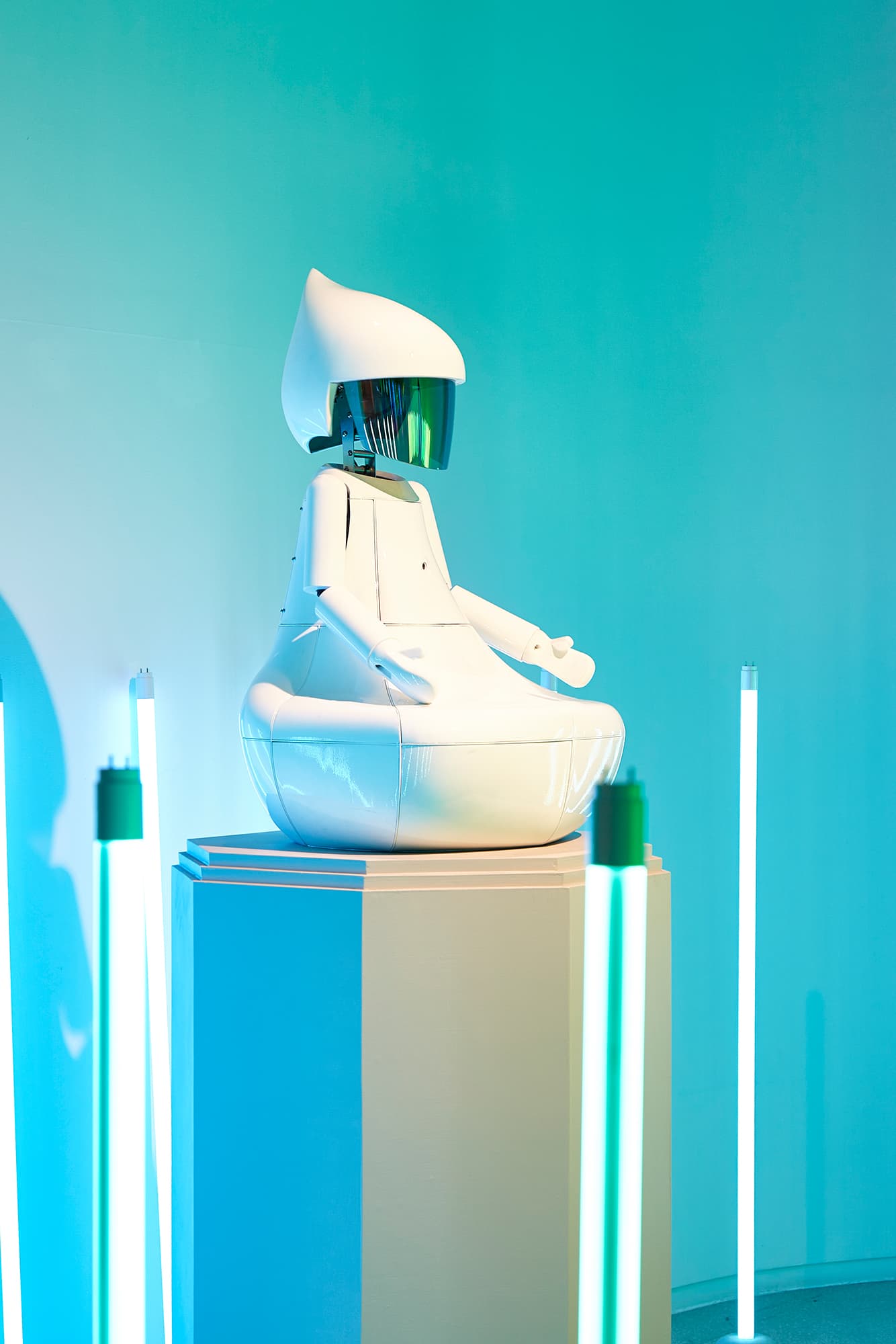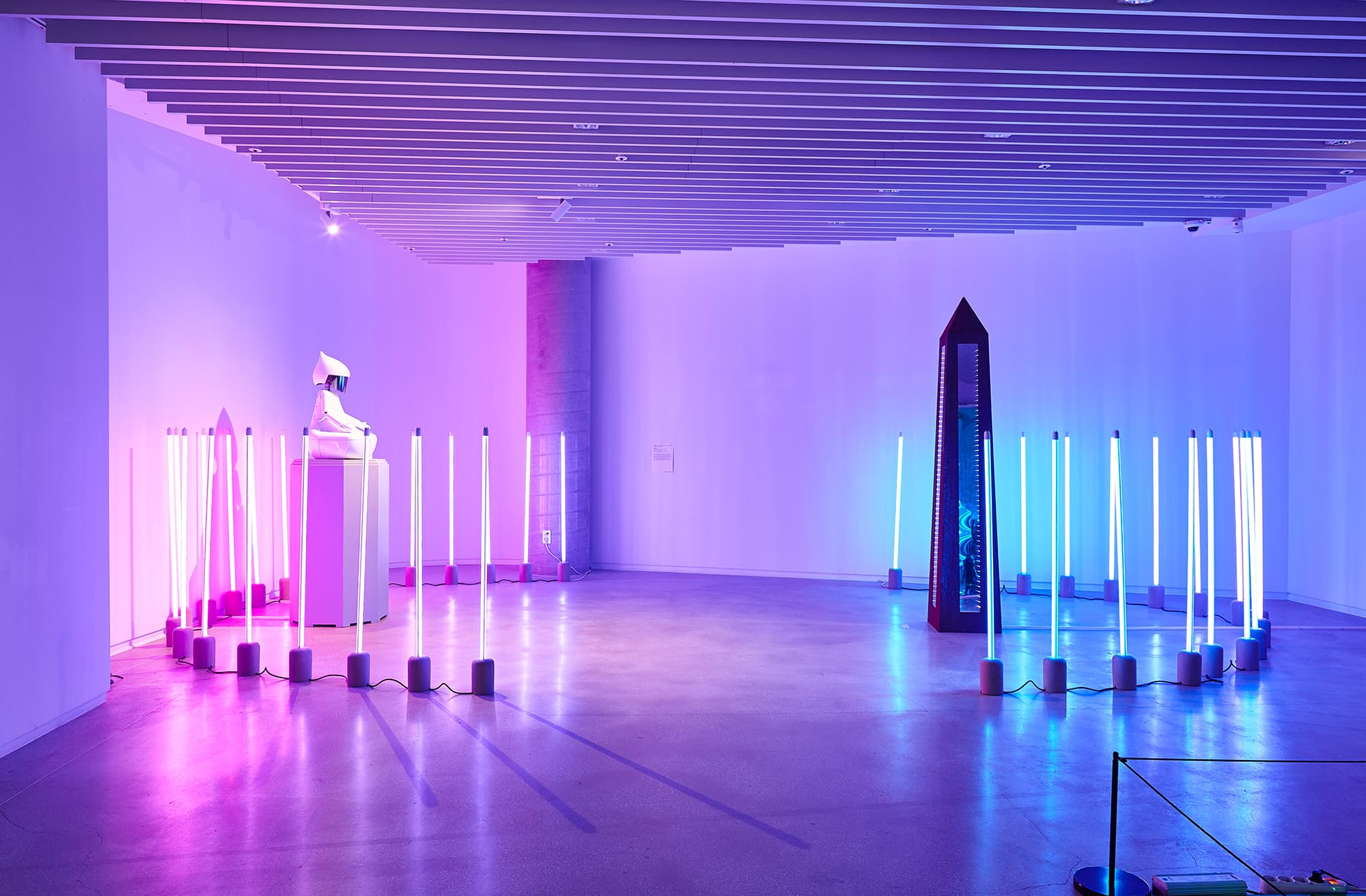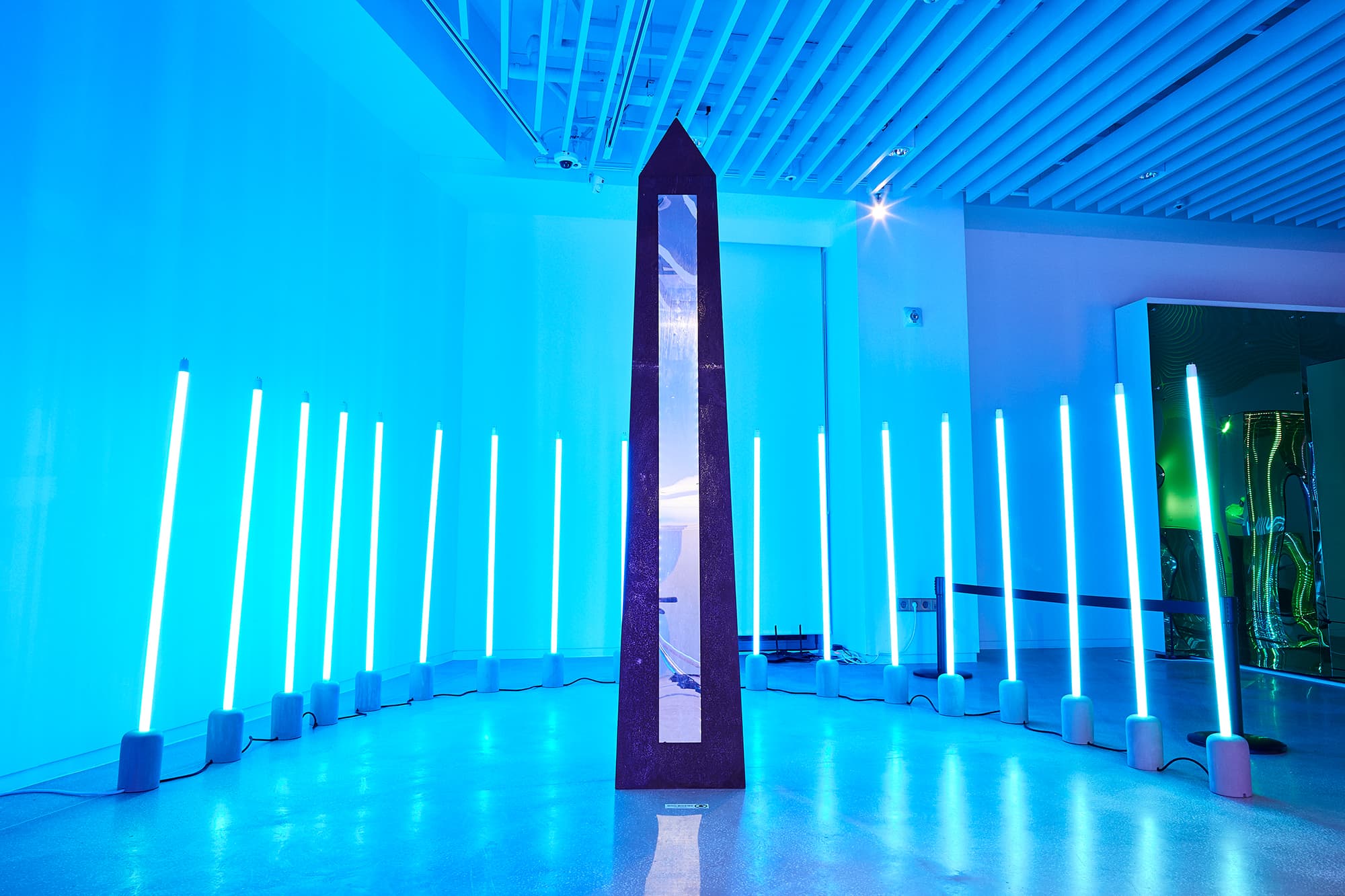What do you want to say, a robot with a cross-legged seat? In 2007, Korea made an attempt to enact the “Robot Ethics Charter”, for the first time in the world. Unfortunately, only the draft was built and it became fuzzy, but Lovot Lab confesses that we want to continue to bring out this great attempt.
While the lights light up side by side, a robot in the shape of a Buddha sits with a cross-legged seat. Humans stand in front of him and listen to the message the robot delivers based on the accumulated data by observing the face through machine learning. <BUDDHA I> creates such an unfamiliar scene, and leads us to hold our hands again into the time of imagination where robots and humans coexist in our instincts. Will artificial intelligence robots predict the fate and future of humans? How much of our lives will depend on them. <BUDDHA I> is a piece of the future that the media artist group LOVOT LAB sees as an artist. On the surface, it is easy to dismiss it as a robot that simply looks at physiognomy, but if you take a step back and weigh each element, you will find the essential message they planted.
It is worth paying attention to the obelisk-shaped lighting sculpture installed where the eyes of the Buddha robot touch. Lovot Lab borrowed the image of the obelisk that symbolized the god of sun from the ancient Egypt, and tried to illuminate the culture of worshiping a certain object or the aspiration of humans dreaming of a higher place. Robots that used to behave mechanically according to a given program now think on their own and go up to the stage of surpassing human values, while others are chasing them as if they worshiped them, and others are already complaining of fatigue from vague fears and rejection. It’s like a mirror that reflects our present lives in the flood of cutting edge technology.
An element that needs to be looked at specially exists inside the obelisk sculpture. This is the original intention that Lovot Lab was trying to put in, and it contains a text file that converts the “Robot Ethics Charter” into data, and accordingly, the LED lights upwards. The artificial intelligence robot in the shape of a Buddha acts as a symbol, and is staring at the code of ethics for coexistence of humans and robots. As if implying the path we need to go forward. No, it feels like asking us humans to face it.
In 2007, Korea attempted to enact the world’s first “Robot Ethics Charter”. In order to anticipate and prepare for the everyday use of robots, the robot ethics council made up of 12 members including scientists, doctors, psychologists, lawyers, and public officials created a draft. “It is surprising to think about the ethical issues that may arise in the development of science and technology at a relatively advanced time at the national level. However, it was a pity that only the draft was done and languished without becoming official.” Hong Hyeon-Soo of Lovot Lab said that when referring to robot ethics around the world, Korea’s ‘Robot Ethics Charter’ is being talked about, and he wants to continue to bring out and talk about this great attempt that contains concerns for the coexistence of humans and robots.
Robot Ethics Charter
Chapter 1 (Goal)
The goal of the Robot Ethics Charter is to confirm the human-centered code of ethics for the coexistence and co-prosperity of humans and robots.
Chapter 2 (Common Principles of Humans and Robots)
Humans and robots must observe the dignity of life, information, and engineering ethics.
Chapter 3 (Human Ethics)
Humans must always judge and make good decisions when manufacturing and using robots.
Chapter 4 (Robot Ethics)
Robots are friends, helpers, and companions who obey human commands and must not hurt humans.
Chapter 5 (Manufacturer Ethics)
Robot manufacturers manufacture robots that protect human dignity, and are obligated to recycle robots and protect information.
Chapter 6 (User Ethics)
Robot users should respect robots as human friends, and illegal modification or abuse of robots is prohibited.
Chapter 7 (The Promise of Action)
Governments and local governments must implement effective measures to embody the spirit of the Charter.
Humanity is standing on a road that has never been taken. Should robots be viewed simply as tools for humans or as the birth of a new species? With the advent of intelligent robots, various social issues are being raised, and Lovot Lab is melting the meaning and importance of the “Robot Ethics Charter” through the eyes of artists. Lovot Lab is a media artist group composed of Shin Won-Baek, Lee Seol, and Hong Hyun-Soo, and continues to create media art in various genres based on digital technology. Since technology itself is both a material and resource at the same time, attention must be paid to the social phenomena that appear due to the development of science and technology.
There is a series of <VACUUM TUBE> that are in line with the idea of <BUDDHA I>. <VACUUM TUBE I>, an interactive video work, visualized the text data of the ‘Robot Ethics Charter’ through the blinking of a vacuum tube, which became the cornerstone of all electronic technologies, on each tube image of 8 channels in bits, the smallest data unit of a computer. <VACUUM TUBE II> is also an interactive object that converts text containing information on robot ethics in a vacuum tube into data and expresses it with electric energy.
When artificial intelligence or robots become indistinguishable from real humans, what do we believe to be humans or not? The interactive movie <LOVOT>, which started out of these concerns, asks questions about the new form and value of ‘love’ that can appear in the age of artificial intelligence, while Lovot Lab recreates the concerns about the relationship between humans and robots. Through the medium of a movie that is familiar to us, it induces deliberation on robot ethics by constructing a story that falls into the emotions of the characters.
In a future environment where the distinction between living and non-living things becomes blurred, we can certainly expect a big change in subject of sharing emotion. Lovot Lab reminds us that we already experienced this indirectly from an issue that raised Japanese society with the pet dog robot Aibo, which was sold by Sony in 1999. Aibo, which sold about 1 million units at the time, had a really low level of artificial intelligence, but in an aging Japanese society, the lonely elderly living alone loved robots as if they were raising them for more than 10 years, and they gave funerals for broken robots. Meanwhile, the interactive movie <LOVOT> also deals with the story of the fate of a robot that has acquired character or has not. On the contrary, this would be a question of human values. The relationship between lifeless machines and humans, exchanges of new emotions, and ethical issues that were not before. The setting of <LOVOT> sounds like a story of reality that is right before our eyes, not at all vain, or anxiety in the distant future.
The time has come; the time to discuss the code of ethics to prepare for an uncertain future where humans and robots coexist. We must ensure that all of us are safe from possible dangers. It is time to regulate the behavior of humans who design, manufacture, and use robots, and robot ethics is needed to prevent social conflict. This is the value that the government was contemplating early on in 2007, and the value that Lovot Lab, which is engaged in artistic activities based on digital media technology, is constantly trying to highlight. While the artificial intelligence-powered Buddha robot delivers a message to humans and stares at the unfinished “Robot Ethics Charter,” we must also remember him. Drawing a peaceful coexistence between humans and robots.




